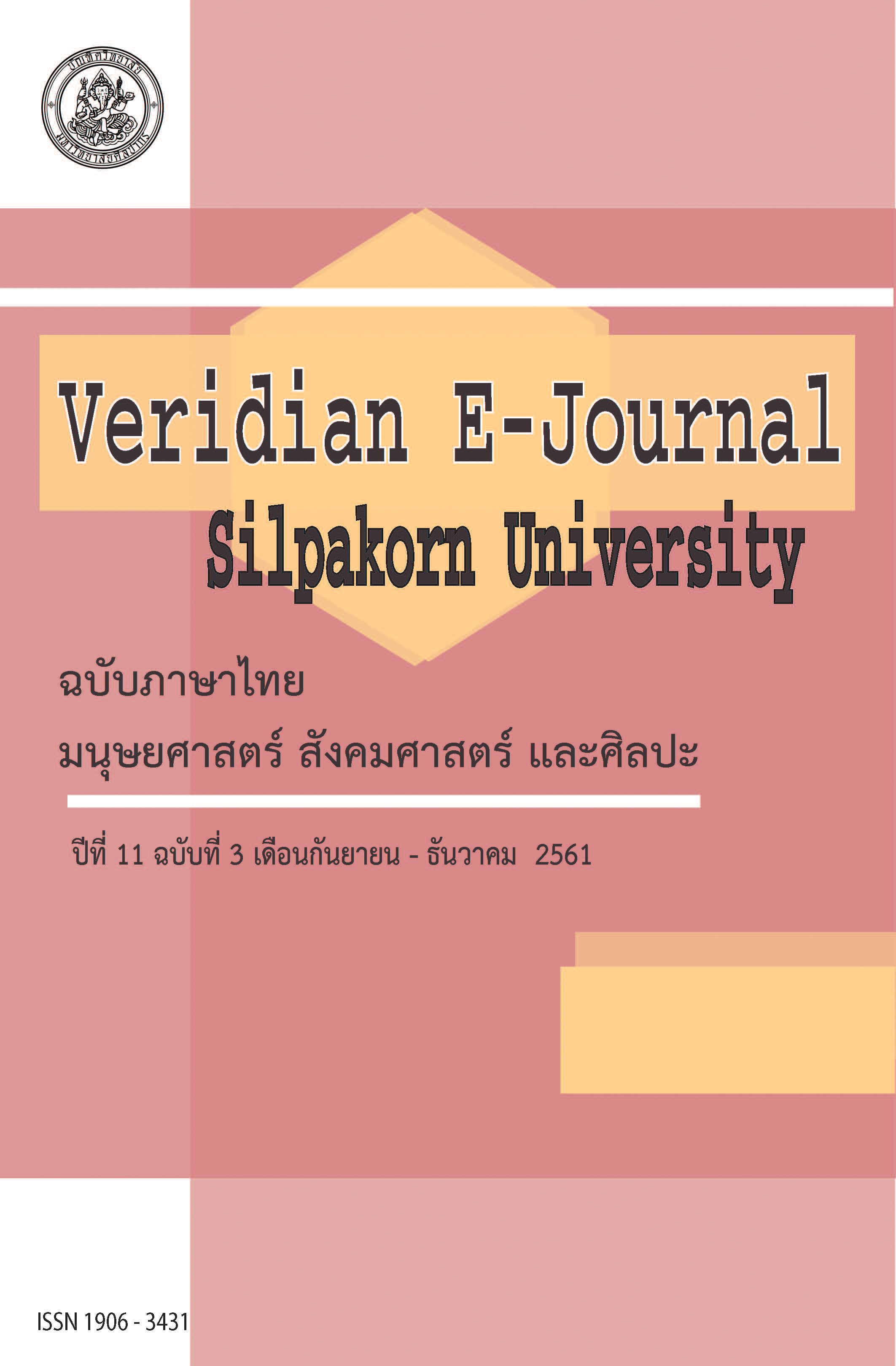ภูมิปัญญาในการทำระฆัง กระดิ่ง กระพรวนของชุมชนชาวไท-ยวน บ้านเขาลอยมูลโค ตำบลดอนตะโก อำเภอเมือง จังหวัดราชบุรี (Local wisdom for bells in the Thai-yuan community: A case study of Bankhaoloymoonko Dontago sub-district, Muang district, Ratchaburi province)
Main Article Content
Abstract
การวิจัยครั้งนี้มีวัตถุประสงค์ 1. เพื่อศึกษาประวัติชุมชนชาวไท-ยวน บ้านเขาลอยมูลโค ตำบลดอนตะโก อำเภอเมือง จังหวัดราชบุรี 2. เพื่อศึกษาภูมิปัญญาในการทำระฆัง กระดิ่ง กระพรวน ชุมชนชาวไท-ยวน บ้านเขาลอยมูลโค ตำบลดอนตะโก อำเภอเมือง จังหวัดราชบุรีเป็นการวิจัยเชิงคุณภาพ โดยผู้ให้สัมภาษณ์ที่ผู้วิจัยศึกษาและเก็บรวบรวมข้อมูลในครั้งนี้ คือ ผู้ที่สามารถให้ข้อมูลเกี่ยวข้องกับประวัติและความเป็นมาของชาวไท- ยวน ชุมชนบ้านเขาลอยมูลโค ตำบลดอนตะโก อำเภอเมือง จังหวัดราชบุรี และผู้ที่เกี่ยวข้องกับภูมิปัญญาในการทำระฆัง กระดิ่ง กระพรวนของชาวไท-ยวนชุมชนบ้านเขาลอยมูลโค ตำบลดอนตะโก อำเภอเมือง จังหวัดราชบุรี เครื่องมือที่ใช้ในการวิจัยจากนั้นนำเสนอผลการวิจัยในลักษณะการพรรณนา (Description) และพรรณนาวิเคราะห์ (Analytical Description)
ผลการวิจัยพบว่า ประวัติความเป็นมาชาวไท-ยวน ชุมชนบ้านเขาลอยมูลโค ตำบลดอนตะโก อำเภอเมือง จังหวัดราชบุรี เป็นชาวไท-ยวนที่อพยพมาดินแดนทางตอนเหนือของประเทศไทย ในช่วงแรกที่เข้ามาตั้งถิ่นฐานบริเวณนี้ เป็นชาวไท-ยวนที่แยกย้ายมาจากในตำบลคูบัว ตำบลดอนแร่ เพื่อมาตั้งถิ่นฐานใหม่ ต่อมาได้มีการตั้งชื่อตามสภาพแวดล้อมที่อาศัย ชาวไท-ยวนที่อาศัยอยู่บริเวณนี้จึงเรียกกันว่า ชาวไท-ยวน บ้านเขาลอยมูลโค ภูมิปัญญาการทำระฆัง กระดิ่ง กระพรวนของชาวไท-ยวน ชุมชนบ้านเขาลอยมูลโค ตำบลดอนตะโก อำเภอเมือง จังหวัดราชบุรี เป็นภูมิปัญญาที่เกิดขึ้นจากความรู้ ประสบการณ์ของคนเฒ่าคนแก่ในชุมชน ที่อาศัยอยู่ที่นี่มานับร้อยกว่าปี ภูมิปัญญานี้จึงเป็นภูมิปัญญาที่มีความสัมพันธ์เชื่อมโยงกับธรรมชาติ สัมพันธ์กับการดำรงชีวิตที่สะท้อนรากฐานในการดำเนินชีวิตของคนในชุมชน โดยมีขั้นตอนในการทำระฆัง กระดิ่ง กระพรวน ดังนี้ การทำกระดิ่งขั้นตอนการทำ 18 ขั้นตอน ดังนี้ 1) การปั้นหุ่นดิน 2) การกลึงหุ่นดิน 3) การชุบเทียน 4) การกลึงเทียน 5) การปั้นหู ติดหู ติดชนวน 6) การปิดรูของหู7) การชุบดินนวล 8) การปั้นเบ้า ปั้นฝาเบ้า 9) การใส่ทองเหลืองในฝาเบ้า และหุ้มปั้นเบ้า 10) การเผาเบ้าหลอมทองเหลือง 11) การเททองเหลือง 12) การกะเทาะ 13) การตกแต่งกระดิ่ง 14) การขัดเงา 15) การปั้นลูกฟัด 16) การหลอมลูกฟัด 17) การตกแต่งลูกฟัด 18) การใส่ลูกฟัด
การทำกระพรวน ขั้นตอนการทำ 13 ขั้นตอน ดังนี้ 1) การปั้นหุ่นกระพรวน 2) การใส่ลูกปืน และ ปั้นหุ่น 3) การชุบเทียน 4) การปาดปาก 5) การติดหูกระพรวน 6) การชุบดินนวล 7) การปั้นเบ้า ปั้นฝาเบ้า 8) การใส่ทองเหลืองในฝาเบ้า และหุ้มปั้นเบ้าเพื่อทำการหลอม 9) การเผาเบ้าหลอมทองเหลือง 10) การเททองเหลือง 11) การกะเทาะ 12) การตกแต่งกระพรวน 13) การขัดเงา
การทำระฆัง แบ่งออกเป็น การทำส่วนประกอบของระฆัง และ การทำหุ่นระฆัง
การทำส่วนประกอบของระฆัง มีขั้นตอน ดังนี้ 1) การปั้นชนวน เป็นส่วนประกอบในการนำระฆังไปติดเข้ากับแกนเพื่อนำไปหลอม 2) การปั้นหูระฆัง เป็นส่วนที่ใช้ในการแขวนระฆัง 3) การทำหัวนาค เป็นส่วนประกอบที่อยู่กับตัวของระฆัง 4) การทำลูกฟัด 5) การขดลวดทองเหลือง 6) การตัดใบโพธิ์
การทำหุ่นระฆัง มีขั้นตอนการทำ 13 ขั้นตอน ดังนี้ 1) การกรอกหุ่นโดยใช้แม่แบบขนาดต่าง ๆ 2) การเจาะรูระฆัง 3) การติดหัวนาค 4) การติดหูระฆัง 5) การติดสายชนวน 6) การติดพวง 7) การเข้าเบ้าหรือการกรอกปูน 8) การเข้าเตาเผา 9) การเททองเหลือง 10) การกะเทาะ 11) การตัดแต่งระฆัง 12) การขัดเงาระฆัง 13) การใส่ลูกฟัดและใบโพธิ์
ปัจจัยที่ส่งผลต่อการดำรงอยู่ของภูมิปัญญาในการทำระฆัง กระดิ่ง กระพรวน ชุมชนบ้านเขาลอยมูลโค 1) การเห็นคุณประโยชน์ของภูมิปัญญา 2) การประยุกต์ภูมิปัญญา 3) การส่งเสริมสนับสนุนภูมิปัญญาจากภาครัฐ และเอกชน 4) บทบาทของภูมิปัญญาในสถานศึกษาหรือในหลักสูตรท้องถิ่น
The purposes of this research were 1) study the history of Thai-yuan people at Bankhaoloymoonko, Don Tako sub-district, Muang district, Ratchaburi province. 2) To study the local wisdom of bell, hand bell and small bell of the Thai-Yuan people at Bankhaoloymoonko , sub-district Dontago , district Muang , Ratchaburi province.
This research was a qualitative research, interviewees who conducted for the study and collected this data were those who can provide information related to the history and origin of the Thai-Yuan community, Bankhaoloymoonko, Don Tako district, Muang district, Ratchaburi province and people who involved with the local wisdom of make bell, hand bell and small bell making then represented the results in description and analytical description.
The study found that the history immigrant was immigrated from the northern part of Thailand. During the early period of settling of this area was a Thai-Yuan dispersed from the suburb of Cu Bua, Don Rea district to the new settlers. Subsequently, it was named after the living environment, Bankhaoloymoonko, Don Tako district, Muang district, Ratchaburi province. Bankhaoloymoonko by elder Thai-yuan people who live in the previous period in the community. They lived here for hundreds of years and this local wisdom linked to nature and connected a way of life that reflects the foundations of life in the community. The bell making processes as follows. The bell making process got 18 steps as follows: 1)Ground molding 2) grounding lathe 3) plating candle 4) candling lathe 5) candle the lathe 5) making molded and ear plugged to the slate 6)closing the hole of the hand bell 7) making clay plating 8) molding the molding of the lid 9) the brass insert in the lid. 10) Brass melting furnace 11) Brass casting 12) Cracking 13) Bell decoration 14) Polishing 15) Molding mill 16) Melting mill 17) Decorate mill 18 ) put in mill.
Making of the small bell were 13 steps as follows: 1) Figure molding 2) Bearing insertion and molding 3) Candle plating 4) attaching eradication 5) Bone grafting 6) Plating 7) Molding the candle 8) Put the brass in the lid for melting. 9) burning brass and melting furnace 10) brass casting 11) cracking 12) decorating brass 13) polishing
Bells part making can divide into 2 parts (Bell parts and body)
The bell parts can make of the following steps 1) Molding the fuse as a component of the bell to attach to the core to melt 2) The bell ear was used to hang the bell 3) The head of the Naga was a component of the bell 4) Turbine making. 5) brass wire. 6) cutting pho leaves. making a bell body have 13 steps to do this 1) filling by using a different size template 2) drilling the bell 3) fix the Naga head 4) bell ear attaching 5) the trigger sticking 6) turbine attaching 7) accessing and filling mortar 8) accessing the furnace 9) brass casting pouring 10) cracking 11) Bell trimming 12) Bell polishing 13) attaching Pho leaves and turbine
Factors that affected the wisdom existence of bell, hand bell and small bell making at Bankhaoloymoonko 1) Knowing the benefits of wisdom 2) The applying in wisdom 3) The promotion and support for wisdom from both government and the private sector 4) the role of wisdom in the local school curriculum or in the local course.

